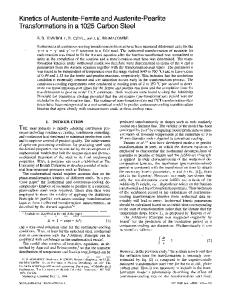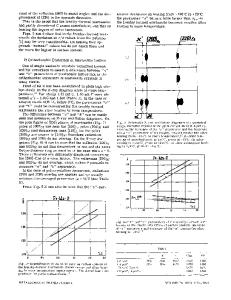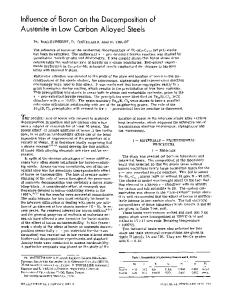Carbon activity in austenite
- PDF / 279,262 Bytes
- 3 Pages / 613 x 788.28 pts Page_size
- 98 Downloads / 348 Views
Table I. Refining of an A l u m i n u m Alloy by Gravity Draining of the Aluminum-Rich Liquid
Initial Composition Drained Liquid Composition at 750~ Drained Liquid Composition at 600~
iI
-10444
I -14420
I -~)+50
SCREEN
I -50,50 MESH
I I -50+100 -ioo,Ho
I -140,200
i -200
SIZE
F i g . 2 - - C o m p o s i t i o n v e r s u s p o w d e r m e s h s i z e of 8 n - 1 5 p c t P b a l l o y r e f i n e d b y a t o m i z a t i o n at 0.4 f r a c t i o n s o l i d .
alloywas that employed by Singleton and Robinson 7 in their refining experiments using a centrifugal separation technique. The drained liquid is significantly lowered in all solute elements present, and its composition is in good agreement with that previously reported/ In the general case, the llquid removed will be either enriched or depleted in alloy elements, depending on the nature of the phase diagram of the alloy. While the two refining processes described in this
Silicon (wt pet)
Iron (wt pet)
30 22.6 13.1
6 4.65 1.77
Titanium (wt pet) 1 0.43 0.15
note a r e batch type, improved economics could be obtained by developing s i m i l a r p r o c e s s e s that operate continuously. The authors acknowledge financial support by the Advanced Research Projects Agency of this r e s e a r c h program. 1. D. B. Spencer, R. Mehrabian, and M. C. Flemings: Met. Trans., 1972, voL 3, p. 1925. 2. G. Reinacher: Metallnd., 1949, vol. 75, p. 183. 3. E. L Jones and A. Tunaes: Cart lnst. Mining Met., 1944, vol. 47, pp. 35. 4. H. W. St. Clair: U.S. Bureau of Mines Report of Investigations (4614), 1949. 5. A. K. Schellinger and M. P. Spendlove: ibid., (5007), 1953. 6. S. A. Ruppert and P. M. Sullivan: ibid., (6417)~ 1964; (6889), 1967. 7. O. R. Singleton and G. C. Robinson, Jr.: J. Inst. Metals, 1971, vol. 99, p. t55. 8. B. M. Larsen: U.S. Patent No. 2,087,347, July 20, 1937. 9. A. Reynor: U.S. Patent No. 2,471,899, May 31, 1949. 10. O. C. Aamot: U.S. Patent No. 3,249,425, May 3, 1966. 11. S. L Dewey: J. Metals, 1965, vol. 17, No. 9, p. 940.
Carbon Activity in Austenite H. M. LEE The activity of carbon in austenite has been extensively investigated by m a n y authors. ~-i~ R has been shown that, at various temperatures, solutions of carbon in a.ustenite begin to depart strongly from quasiregular behavior at low concentrations. This large deviation from Henrian behavior exhibited by austenite has given rise to m a n y theoretical models 11-as to account for thermodynamic behavior of carbon in austenite. In the simple athermal-solution model of an interstitial solid solution, it is assumed that, although all sites are available for occupancy, strong repulsion interactions exist between the neighboring interstitial atoms, so that each interstitial carbon effectively excludes from occupancy by other interstitial atoms. The final equation derived from this model is
Xc a c =k
fl_ZXc
[I]
where /3 is the number of interstitial sites per metal atom, x c the atom fraction of carbon, and z the number of sites blocked by one interstitial atom. In this model, the Parti
Data Loading...










